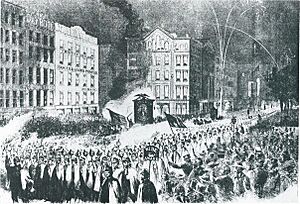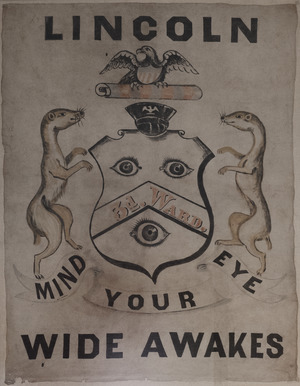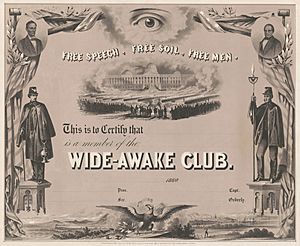Wide Awakes facts for kids

The Wide Awakes were a youth organization that later became a group similar to a military-style organization. The Republican Party formed them during the 1860 presidential election in the United States. They used fun social events, a sense of friendly competition, and even comic books to get young people involved in politics. They saw themselves as the new voice for younger voters. The Wide Awakes were organized like a military group, which appealed to young people who felt unsure about the political problems in the 1850s. They gave young people in the North a clear political identity.
Contents
What Were the Wide Awakes?
In early March 1860, Abraham Lincoln gave a speech in Hartford, Connecticut. He spoke against the spread of slavery and supported workers' right to strike. Five store clerks, who had started a Republican group called the Wide Awakes, decided to join a parade for Lincoln. Lincoln was very happy when they escorted him back to his hotel with torches after his speech.
Over the next few weeks, Lincoln's campaign planned to create Wide Awake groups across the country. They wanted to use these groups to help many new and young voters register. They knew that new voters often support new and younger political parties.
The New York Times described Wide Awake members as "young men of character and energy." They were "earnest in their Republican convictions and enthusiastic" about the election. In Chicago, on October 3, 1860, 10,000 Wide Awakes marched in a three-mile parade. The Chicago Tribune newspaper wrote a long story about this event.
In Indiana, a historian noted that 1860 was a very exciting election year. Political parties worked hard to organize their supporters into clubs. The Lincoln "Rail Maulers" and "Wide Awakes" were the most notable. These groups were active throughout the state. Their members wore colorful uniforms and took part in all Republican events. The Wide Awakes were especially well-trained. They acted like a "political police," escorting speakers and keeping order at public meetings. Every political rally became a chance for big parades with banners, torchlight processions, and fireworks.
By the middle of the 1860 campaign, Republicans proudly said they had Wide Awake groups in every county of every northern (free) state. On the day Lincoln was elected president, the Wide Awakes had grown to 500,000 members. The group stayed active for several decades after that.
How the Wide Awakes Operated

Uniforms and Marches
The typical Wide Awake uniform included a full robe or cape and a black shiny hat. They carried a six-foot-long torch with a large, flaming whale-oil container on top. Their activities mostly happened at night. They held many torch-lit marches through cities in the northeast. The Wide Awakes used the image of a large eyeball as their main symbol on banners.
Local Groups
We don't know much about how the Wide Awakes were organized nationally. It's possible there wasn't one main governing body. The clubs seemed to be set up by city into local groups. Records from the Waupun, Wisconsin, group show that only males 18 and older could join. Members had to "furnish himself with the style of uniform adopted by this Club." Each group had a military-style officer system. This included a captain and several lieutenants.
The captain was in charge of the group at all times. If the captain was not there, the lieutenants would take command based on their rank. Every member had to attend all meetings, whether regular or special. When on duty or at meetings, they had to obey the officers in charge. They also had to do any tasks the officers asked of them.
Social Activities
Marching clubs from both political parties often had bands and fancy uniforms. These groups were also important for social life.
Young men and boys who joined groups like the Wide-Awakes bought inexpensive uniforms. They learned impressive marching moves. In Marion, the Wide-Awake uniform included an oil cloth cape and cap, and a red sash. This, along with a lamp or torch, cost $1.33. Their "worm fence march" was a special move. It connected them to Lincoln, who was known as a "rail splitter." This reminded people of earlier campaign symbols like log cabins and hard cider.
Joining these clubs also connected to the "militia fever" of the 1850s. Many Americans, both North and South, loved military uniforms and titles. They enjoyed musters, parades, and formal balls their companies held in winter. Younger boys liked to copy them, especially with affordable uniforms. Parents saw this as a way to channel youthful energy into a disciplined, military-like form.
Campaign clubs also offered a social attraction. One of the first things a new club did was invite "the ladies" to meetings. Many members were single young men. The campaign happened during a quieter social time of year. It was after summer picnics and before winter balls. Campaign clubs helped extend social seasons for young men and women. They gave them a chance to travel and have fun.
Their Goals
Many Wide Awakes groups had an unofficial list of goals. Here are some examples from the Chicago group:
- To act like a political police force.
- To escort all important Republican speakers who visited their city.
- To attend all public meetings and make sure order was kept. They wanted to ensure the speaker and meeting were not disturbed.
- To be at the voting polls and make sure every legal voter was treated fairly.
- To act in a way that encouraged all Republicans to join them.
- To be a large group working together for the success of the Republican Party.
Membership Certificate
The Wide Awakes membership certificate had a picture in the middle. It showed crowds and troops in front of the US Capitol building. Some troops marched in long lines, while others fired cannons into the air. Crowds stood on the Capitol steps, next to a single figure, likely Abraham Lincoln, walking towards the entrance.
The certificate had an American flag draped over a rail fence as a border. Olive branches were at the top. In the upper corners were round pictures of Lincoln (left) and his running mate, Hannibal Hamlin (right). Tools for splitting rails were in the corners. A watchful eye looked down from clouds in the center. On each side stood uniformed members of the group. They wore their short capes and hats. One held a staff and a lantern, and the other held a burning torch. Below, an eagle on a shield held a banner that said "E Pluribus Unum." It also held arrows and an olive branch. Broken chains lay in front of the eagle.
In the background on the left, the sun rose over mountains, and a train moved across the plains. On the right, there was a more industrial scene: an Eastern city with a busy harbor. In the front, a man hammered a wedge into a wooden rail.
Stone's Prairie Rally
In August 1860, a political rally was planned at Stone's Prairie in Adams County, Illinois. This area was familiar to two of the presidential candidates. Abraham Lincoln was known there, and his opponent, Stephen Douglas, had practiced law nearby. Adams County was also close to Missouri, which was a slave state. This caused some local tension.
Republicans organized the rally. They first invited Democratic speakers, but later took back the invitation. This caused confusion, as many people still thought it would be a debate between both parties.
During the 1860 campaign, it was common for towns to put up tall poles, sometimes 150 feet high. Political parties would hang flags and dolls of the candidates they opposed from these poles.
On their way to the rally, the Quincy Wide Awakes passed through Payson. The people of Payson had put up a pole with an offensive doll of Lincoln. However, the Wide Awakes carried a banner with an equally offensive picture of a drunken Douglas. A fight was avoided, and the Wide Awakes continued to Stone's Creek.
About 7,000 people attended the rally on August 25, 1860. Democrats came expecting to hear their candidates debate. Instead, they found only Republican speakers, whom they booed. The Wide Awakes defended their speakers, and a large fight broke out involving hundreds of men.
After the rally, the Wide Awakes returned through Payson. They found about a hundred Democrats guarding their pole. Although the Wide Awakes tried to avoid a fight, shots were fired at them as they left town. Their flag was hit by bullets, and several members were reported to be injured.
Southern Concerns
In 1860, Senator Louis T. Wigfall from Texas wrongly claimed that Wide Awakes were behind fires and damage in his home state of Texas. Historians have found no proof of such a plan. However, in Texas in 1860, a widespread fear of slave revolts, which were not actually happening, led to violence against many slaves and white people. This event was called the Texas Troubles.
The Wide Awakes never marched in the South in 1860. But they represented the South's biggest fear: an attacking force that would come to their lands, free the slaves, and destroy their way of life. Their uniforms and equipment made this fear even worse. People believed they would "parade at midnight, carry rails to break open our doors, torches to fire our dwellings, and beneath their long black capes the knife to cut our throats." To the South, the Wide Awakes showed what they thought would happen if Lincoln became president. They believed the North would not compromise and would force its will upon the South. One person said, "One-half million of men uniformed and drilled, and the purpose of their organization to sweep the country in which I live with fire and sword."
This fear was not calmed by how popular the Wide Awakes were in the North. On October 25, 1858, Senator Seward of New York told an excited crowd that "a revolution has begun." He hinted that the Wide Awakes were "forces with which to recover back again all the fields... and to confound and overthrow, by one decisive blow, the betrayers of the constitution and freedom forever." To the South, it seemed the Wide Awakes and the North would only be happy when the South was completely controlled.
The South realized they needed their own version of the Wide Awakes. They started a movement to create a "counteracting organization in the South," called the "Minutemen." The South saw the Wide Awakes as the North's private army. So, they decided to create their own. They would no longer tolerate the "abhorrence of the rapine, murder, insurrection, pollution and incendiarism which have been plotted by the deluded and vicious of the North, against the chastity, law and prosperity of innocent and unoffending citizens of the South." The Minutemen became the South's unofficial army. Like the Wide Awakes, they were expected "to form an armed body of men... whose duty is to arm, equip and drill, and be ready for any emergency that may arise in the present perilous position of Southern States." The fear of the Wide Awakes led to Minutemen groups forming all over the South. Like their rivals, they also held torch rallies and wore their own uniforms. Their official badge was "a blue rosette... to be worn upon the side of the hat."
During the War
After Lincoln called for all militias in April 1861, many groups volunteered for the Union army. This included the Republican Wide Awakes and the Democratic "Douglas Invincibles." In 1864, reports of political rallies mentioned the "Northwestern Wide Awakes" and others at a Chicago meeting. On November 5, the Chicago Union Campaign Committee, Lincoln's party that year, announced:
"On Tuesday next the destiny of the American Republic is to be settled. We appeal to Union men. We appeal to merchants to close their stores, manufacturers to permit their clerks and laborers to go to the polls, the Board of Trade to close, the Union Leagues and Wide Awakes to come out. The rebellion must be put down."
Defending St. Louis
In early 1861, the Wide Awakes group in St. Louis became involved in military-like actions. This happened when the American Civil War began. With help from Francis Preston Blair, Jr. and Army Captain Nathaniel Lyon, the St. Louis Wide Awakes secretly brought weapons into the city. They also trained in a hidden warehouse. Their goal was to prepare to defend the federal St. Louis Arsenal. Supporters of the Confederacy wanted to take control of this arsenal.
Captain Lyon used his political connections through Blair to become the commanding officer of the arsenal. Once he had this role, he quickly moved the St. Louis Wide Awakes into the arsenal under the cover of night.
Lyon's Wide Awakes, who had just joined the Union Army, were used on May 10, 1861. They arrested a division of the Missouri State Militia near St. Louis. This event became known as the Camp Jackson Affair. As the captured militia men were marched towards the arsenal, a riot broke out later that day. Many civilians were shot or killed. That event marked the true start of the Civil War in Missouri.


